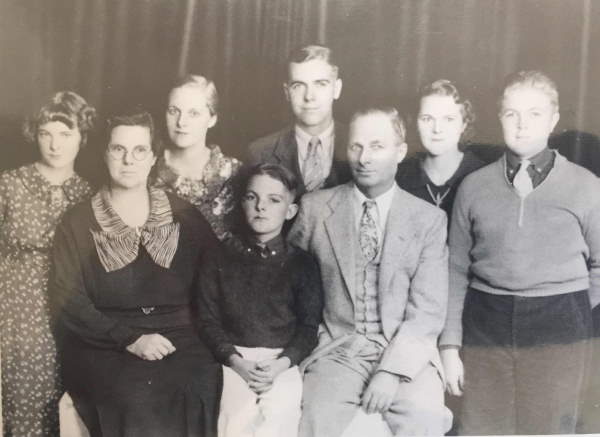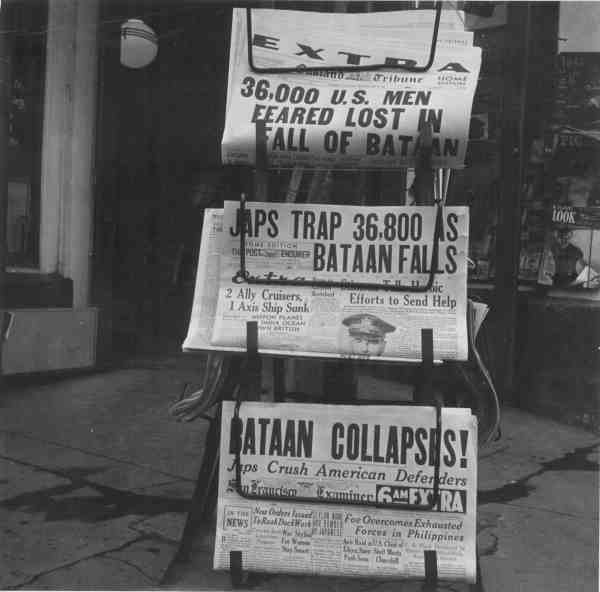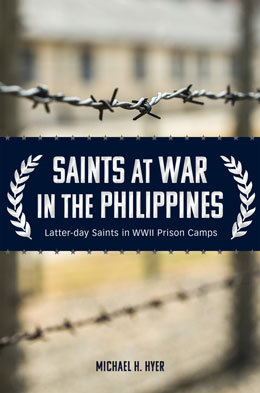Back Home
The world has need of willing men
Who wear the worker’s seal.
Come, help the good work move along;
Put your shoulder to the wheel.
—Will L. Thompson, “Put Your Shoulder to the Wheel”
Back in the United States, the families of these soldiers had settled into life on the home front. The Brown family in El Paso was typical. Ruby, Lieutenant Brown’s mother, threw herself into various kinds of volunteer work in support of the war effort, including acting as a volunteer Red Cross worker, an air raid warden, and a member of the Bundles for Britain project, as well as serving in the rail station canteen for servicemen.[1]
Brown’s father, George, was busy as a US marshal, transporting prisoners to various federal institutions.[2] During this time, he was also a witness in a high-profile trial involving a Nazi spy ring based in El Paso.[3] Other siblings were also involved in the war effort at home. Brown’s youngest sister, Fern, volunteered as a nurse’s aide at the Masonic hospital and also kept busy dating Latter-day Saint servicemen training at Fort Bliss or Briggs Field in El Paso.[4]
 The Brown Family in El Paso, Texas, in 1936 before the war. Back row, left to right: Fern, Nelle, Bobby, and Jane. Front row, left to right: Ruby, Rulon, George, and Paul. Courtesy of the Brown family collection.
The Brown Family in El Paso, Texas, in 1936 before the war. Back row, left to right: Fern, Nelle, Bobby, and Jane. Front row, left to right: Ruby, Rulon, George, and Paul. Courtesy of the Brown family collection.
Rulon, Brown’s youngest brother, was unable to serve in the military for physical reasons and instead served the war effort in another way. He became a captain in the Briggs Field Fire Department.
Briggs Field, which was located near El Paso, became a major training facility for B-17 bomber pilots. One of the often-overlooked tragedies of the war was the number of accidents and fatalities in flight training: some fifty-three thousand accidents in the continental United States resulted in the loss of approximately fifteen thousand pilots and other crew members.[5] A number of those accidents involved those training at Briggs Field and typically involved a deadly encounter with Mount Franklin near El Paso. The principal activity of the Briggs Field Fire Department was rescuing the downed flight crew members—or, more often, recovering their charred remains. These rescues were neither easy nor safe, but Rulon became an innovative and distinguished rescuer.[6]
During WWII, government censorship of war news was strict and pervasive. The public saw only carefully screened information about the war. Details of casualty statistics, strategic failures, or any visual proof of dead or maimed soldiers were censored.[7] The author has a copy of a stack of newspaper clippings of stories on the war in the Pacific, and the Philippines in particular, that Ruby carefully clipped and saved. With respect to this period on Bataan prior to surrender, these newspaper articles all evince a positive sentiment about the Americans bravely defending Bataan and Corregidor with headlines such as “Battered Yanks Exact Heavy Tool for Nippon Gains,” “Smashing Air Blow Downs Thousands of Japanese,” and “American Troops on Bataan Beat Back Japanese Patrols.”
While a few of the stories acknowledged the difficulty in supplying the troops on Bataan, they gave few hints to the desperate condition of the Bataan troops. In a later story about the surrender in Bataan, the local El Paso paper quoted Ruby as saying, “I trust President Roosevelt and I trust the Lord, but I can’t help asking, why didn’t they take them to Corregidor yesterday?”[8] Cleary, Ruby had no appreciation for the desperate state of affairs in the Philippines—Corregidor was as doomed as Bataan—and, although it may have been for the best, Ruby did not understand that President Roosevelt had already “regrettably written off” the Philippines back in December.
A month or so after the surrender on Bataan, some of the families of the surrendering soldiers began receiving notices from the government. On May 16, 1942, the Browns received a letter from the army adjutant general, informing them that according to military records, their son was serving in the Philippines at the time of the surrender. The letter also stated that in the days before the surrender, there were casualties that were not reported to the War Department and that it “could not give you positive information” in that regard. However, the letter stated that the Japanese government had indicated its intention to comply with the provisions of the Geneva Convention on the exchange of information. That would include providing a list of prisoners. The letter expressed the War Department’s intent to notify the Browns if his name was on such a list, but until then, he would be considered “missing in action.”[9]
 American newspapers report the fall of Bataan. Courtesy of UC Berkeley, Bancroft Library. Photo taken by War Relocation Authority, an agency of the United States Government.
American newspapers report the fall of Bataan. Courtesy of UC Berkeley, Bancroft Library. Photo taken by War Relocation Authority, an agency of the United States Government.
The uncertainty for the Browns was even more complicated. The May 16 letter referred to “Master Sergeant George R. Brown, 20,842,49.” However, previous correspondence from the army had referred to “First Lieutenant George R. Brown, 0-890150.” Given that both “George” and “Brown” are common names, there was another round of correspondence with the War Department to determine whether the letters were referring to the same person. In a letter dated July 29, 1942, the War Department explained the discrepancy and confirmed they were referring to the same person.[10]
Finally, on December 15, 1942, more than eight months after the surrender on April 9, the Browns received a telegram from the War Department:
YOUR SON FIRST LIEUTENANT GEORGE R BROWN ARMY OF THE UNITED STATES REPORTED A PRISONER OF WAR OF THE JAPANESE GOVERNMENT IN THE PHILIPPINE ISLANDS.[11]
This news, coming shortly before Christmas, was received by the Browns as their most precious Christmas present. While Bobby was a POW, they now knew he was alive. [12]
A similar period of fearful apprehension was also playing out in the Davey family in Salt Lake City. Since the start of the war and throughout the Battle of Bataan, Captain Davey’s sister, Hazel, and brothers, Lee and Ralph, had been on a constant vigil for information about their brother Bob. Hazel continued to write letters to her brother, even though they all came back labeled Returned to sender; service suspended. When Bataan fell, the Davey family feared their worst fears might have been realized. Indeed, on September 15, 1942, the Salt Lake County Chapter of the Service Star Legion sent Hazel an invitation to the Public Reception and Tea and a gold star. Hazel, however, returned the gold star and never displayed it, as she did not consider her brother dead.[13]
On November 11, 1942, the Deseret News published a list of those who had died or were reported missing in action in the Philippines. Captain Davey was on that list—not as one who had died, but as one who was “missing in action since May 1942.” That wasn’t exactly good news, but it was not the worst news either. Later, on December 13, Hazel received a telegram from the War Department:
YOUR BROTHER CAPTAIN ROBERT GRAY DAVEY, FIELD ARTILLERY REPORTED A PRISONER OF WAR OF THE JAPANESE GOVERNMENT IN THE PHILIPPINE ISLANDS.[14]
His brothers and sister now knew he was alive. Just as with the Brown family, although it was not the best news, it was nevertheless good news.
Hazel also now had an address to use to write letters to her brother. During her brother’s imprisonment, she conscientiously wrote him about four letters a week, even though there was really no assurance or even likelihood that the letters would ever reach him. Hazel was not the only one sending letters. Brothers Lee and Ralph also wrote, as well as aunts, uncles, nephews, and nieces. Davey’s twelve-year old niece, Joanne, wrote in a very firm block print, “Dear Uncle Bobby, Hope you are well. We are praying for you. Keep your chin up. May God bless and protect you always. I miss you. Love, Joanne.” Sadly, Captain Davey received only a few of these letters, and even those were not delivered until months after they had been written.[15] The fate of her brother Bob, however, was not the only concern weighing on Hazel’s mind. Her own sons were sent to war in Europe, and her brother Ralph was serving in India.
For the rest of America, however, after the surrender of the Philippines, the abandoned boys of Bataan faded from public discourse and for a time were largely forgotten.[16] Perhaps recognizing that interest in the Bataan POWs was increasingly overshadowed by events in Europe and elsewhere, George Brown again wrote Congressman R. E. Thomason on June 20, 1943, urging him to make efforts to contact the POWs and to provide food and medical aid. George closed the letter with the following plea: “I fully realize the apparent impossibility in this situation but I sincerely believe that if strong enough effort is made by proper men and enough of them, we can still reach our boys with succor before it is too late. But Mr. Thomason, when everyone is busy in great problems the only way we can get attention in this matter is to keep insisting til we make our point, and please remember, ‘The Lord helps those who help themselves’ and we can’t expect him to do it all.”[17]
The Browns, the Daveys, and the other Latter-day Saint families of these POWs were people with great faith. With the public and government’s attention largely elsewhere, this faith would now be tested with prolonged silence.
Notes
[1] Zundel, “Brown Family History,” 3; Ruby Brown, “Personal History,” 6.
[2] Zundel, “Brown Family History,” 2.
[3] Ruby S. Brown, “Twenty Years Ago—1934–1954,” vol. 4 (1954), item G, 13 (Ruby S. Spilsbury Collection), 2. The story of this infamous Nazi spy ring is recounted in Clint Richmond, Fetch the Devil: The Sierra Diablo Murders and Nazi Espionage in America (Lebanon, NH: ForeEdge, 2014).
[4] Fern Brown Hyer, “Classy Grandmas All Come from Chupe” (unpublished personal history manuscript in possession of author), 8, 36–37 (Fern is the second youngest in the Brown family and the author’s mother); Zundel, “Brown Family History,” 7.
[5] United States Air Force Statistical Digest of World War II, December 1945. Table 213, 309. Accessible at https://
[6] Zundel, “Brown Family History,” 8. Rulon invented a number of the tools used to extract crewmen from the wreckage and obtained a pilot’s license, enabling him to fly L-19 Bird Dog (Cessna Model 305) aircraft to look for downed planes. In one instance, he lowered himself down a cliff to rescue a downed pilot, but found only a burned torso, which he tied to his own and ascended the cliff. He smelled so bad that on the trip back the crew made him ride on the top of the fire truck. In a successful but more dangerous rescue, the pilot had to be cut out of the plane with a blowtorch while Rulon was standing in high-octane gas up to his knees. They recuperated together in the same hospital. Robin Brown (Rulon Brown’s son), personal conversation with author.
[7] Lukacs, Escape from Davao, 281–82; see Holmes, Unjust Enrichment, 2.
[8] Article is in a newspaper clipping dated April 10, 1942, kept by Ruby Brown. The name of the newspaper is not indicated on the clipping.
[9] Major General Ulio, The Adjutant General, War Department, to George A. Brown, dated May 16, 1942, NARA Records.
[10] Major General Ulio, The Adjutant General, War Department, to Mrs. George A. Brown, dated July 29, 1942, NARA Records.
[11] Telegram, Major General Ulio, The Adjutant General, War Department, to George A. Brown, dated December 15, 1942, NARA Records.
[12] This sentiment was written on a Christmas card from the Browns and was saved by family members with other items related to Bobby.
[13] Springgay, “Davey,” 43–44. The gold star is the nation’s way of honoring families with an immediate family member who died in combat in the service of their country.
[14] Springgay, “Davey,” 44.
[15] Springgay, “Davey,” 43–44.
[16] Lukacs, Escape from Davao, 282–83.
[17] George A. Brown to Honorable R. E. Thomason, June 20, 1943, NARA Records.
